The Long and Winding History of the Thames
Float down England’s longest river, from its origin in the Cotswolds to its ramble through London, a journey through centuries of “liquid history”
/https://tf-cmsv2-smithsonianmag-media.s3.amazonaws.com/filer/Thames-river-kayakers-631.jpg)
Steve Brooker treads through a sea of slime, protected by rubber boots and fisherman’s coveralls, stopping every few feet to probe the soggy ground with his trowel. “We’re looking for pure black mud,” the tall, gaunt 50-year-old marathon runner and commercial window fitter tells me. “The black mud is anaerobic—there’s no air in it. If we chuck your trainer in,” Brooker adds, using a British word for running shoe, “it will survive for 500 years.”
Brooker has taken me to a stretch of the Thames flowing past Greenwich, a district in south London, to inspect a nearly 600-year-old garbage dump at the former site of Placentia Palace—the main residence, demolished in the 17th century, of King Henry VIII and birthplace of Queen Mary I and her half-sister, Queen Elizabeth I. Here, members of the royal staff discarded everything from oyster shells to the pins used by the Elizabethans to secure their high frilled circular collars. Now it’s a favorite digging spot for Brooker and his Mudlarks, amateur archaeologists licensed by the city who prowl the banks of the Thames searching for fragments of London’s history.
The Mudlarks take their name from 19th-century street urchins who foraged along the river. “They were the lowest of the low,” says Brooker. “They scavenged for rags, bits and pieces of boats, anything they could sell.” Brooker has made his way along virtually every inch of the Thames as it winds through London, studying the river’s tides and flow. He’s one of the group’s most prolific spotters, as well as a minor celebrity who stars in “Mud Men,” an ongoing History Channel UK documentary series. He calls himself the “Mud God.”
As we walk along the river’s edge, Brooker bends down and plucks from the ooze what looks like a thin copper farthing. He identifies the coin as a 17th-century “traders’ token” distributed by candlemakers, butchers and other shopkeepers during government coin shortages and accepted in lieu of cash. Other recent finds include a finely carved wooden harpoon some 4,000 or 5,000 years old, an iron ball and chain worn by a prisoner from the 17th or 18th century, decorated stoneware from the 1600s and 1700s, and the 200-year-old skeleton of a teenage girl.
At 215 miles, from the Cotswold Hills to the North Sea, the Thames is England’s longest river, and mile for mile has witnessed more than its share of epochal events. Julius Caesar crossed the river he called the “Tamesis”—from a Celtic root word meaning “dark”—in 54 B.C. On June 15, 1215, twenty-five barons forced King John to sign the Magna Carta at Runnymede, beside the Thames. Oxford University came into being on the river’s north bank. Conspirators gathered at Henley-on-Thames (now the site of the famous regatta) to plot the Glorious Revolution of 1688 that overthrew Catholic King James II and brought Protestant William and Mary to the throne. Dozens of kings and queens were born, lived and died along the river, at the castles of Hampton Court, Placentia and Windsor. When an American congressman compared the Thames unfavorably with the mighty Mississippi, 2,320 miles long, the trade unionist and M.P. John Burns replied: “The Mississippi is muddy water, but the Thames is liquid history.”
On July 27, a Thames pageant unfolds before hundreds of millions of viewers: the bearing of the Olympic torch on a floating stage from Hampton Court to the Olympic Stadium at Stratford. Although the Thames will not be used in any of the competitions to follow, Dorney Lake, also known as the Eton College Rowing Center, an artificial waterway just beside the river, will be the site of some of the Games’ most popular events: rowing regattas and canoe races.
As Londoners prepared for the Thames festivities (including the Queen’s Diamond Jubilee celebration on the river in June), I decided to follow the river by boat and on foot, hiking the Thames Path—a 184-mile trail between the Cotswolds and Teddington Lock just outside London. I was eager to make a pilgrimage to some of the places where England’s kings and queens, literary lions and aristocrats had lived and played. I had also heard that the Thames upriver had barely changed in recent centuries, and I wanted to find out if it was even now a waterway, as the 18th-century novelist Daniel Defoe put it, “made glorious by the splendor of its shores.”
I began in Lechlade, a quaint market town 90 miles west of London, where the waterway is a 30-foot-wide creek. I boarded the Bacchanalia, an electric-powered cruiser skippered by Ashley Smith, a former lockkeeper’s assistant and resident of Oxford. (The vessel gets 12 hours on a single battery charge and relies on a handful of charge points between Lechlade and London.) Motoring silently at the maximum permissible speed of five miles per hour—to avoid damaging the Thames’ fragile banks—we passed groves of willow and hawthorn trees and fields covered with Queen Anne’s lace and cow parsley, as swans, mallards and black-headed coots paddled among the reeds.
A few minutes past Lechlade, we reached St. John’s Lock—the first of 47 locks on the Thames, some of which date back nearly 400 years. A lock is a kind of nautical elevator, allowing boats to be lowered or raised at a point where the river level drops sharply; boats enter a narrow chamber, the gates are sealed and water flows through sluices in the gates until the level inside the lock equals that of the river. Today, the ten locks from St. John’s to King’s near Oxford function as they have for centuries, with manually operated gates and lockkeepers who live beside the river.
At Grafton Lock, constructed in 1896, lockkeeper Jon Bowyer greeted Smith warmly; he had once been Smith’s boss. In medieval times, Bowyer told us, there had been no locks on the Thames, only dams, or weirs, controlling the water’s flow and providing power to mills along the banks. Boatmen navigating the river were forced to “shoot the weir,” racing through a slot opened in the dam—“made of turf and wood in those days, really ramshackle affairs,” Bowyer said—or portage their vessels around the obstruction. The first locks appeared on the Thames in the 17th century—based, some say, on a design by Leonardo da Vinci.
Wearing a sporty orange life vest—the lockkeeper’s standard gear—Bowyer shut the gates behind our boat, sealing us in the chamber. The 15-year Thames veteran then cranked a wheel that opened the downstream sluice. The gray-green water poured out of the lock in bubbling eddies; we could feel our vessel steadily descend. “We have to push and pull a bit,” Bowyer said, opening the downstream gates to let us through, sending us on our way with a cheerful wave.
I spent the night at the Rose Revived, an inn from the 1500s. It sits beside a 12-arched stone span that monks built in the 13th century to improve commerce in southern England’s wool-producing towns. Such inns have captured many a traveler’s fancy. “If ever you have an evening to spare, up the river, I should advise you to drop into one of the little village inns, and take a seat in the tap room,” advises the narrator of Jerome K. Jerome’s 1889 comic novel, Three Men in a Boat, an account of a pleasure trip up the Thames to Oxford by a trio of Londoners and their dog.“You will be nearly sure to meet one or two old rodmen, sipping their toddy there, and they will tell you enough fishy stories, in half an hour, to give you indigestion for a month.”
I reached Oxford on my second morning with a new captain, Mark Davies, a scholar of the Thames and writer. He steered the boat beneath one of Oxford’s landmarks, the Folly Bridge, another graceful stone span, built between 1825 and 1827, and which “almost certainly marked the spot of the original ford,” Davies said. First mentioned in the Anglo-Saxon Chronicle in A.D. 910, the town of Oxford was founded at the site of a Thames crossing that served as a defensive position against Viking invaders. Some time later, according to legend, Franciscan friars built a house of studies near the ford, where today alleys still bear names such as Old Greyfriars Street and Friars Wharf. From those modest beginnings, Oxford grew into one of the world’s great centers of higher learning.
The area around the bridge was a fulcrum of activity. Eight-man Oxford crews sliced through the water, as their coaches, on bicycles, shouted instruction from the bank. The terrace at the Head of the River pub adjacent to the bridge was packed. Davies and I docked the boat and followed a path along the River Cherwell, a tributary of the Thames. From Christ Church Meadow, we admired the medieval spires and Gothic towers of Christ Church College, founded in 1524 by Thomas Wolsey, lord chancellor of England, at the height of his power. The college has produced 13 British prime ministers—as well as one of Britain’s most enduring works of literature.
On July 4, 1862, mathematics instructor Charles Dodgson (who wrote under the pseudonym Lewis Carroll), his friend Robinson Duckworth, and the three daughters of Christ Church College dean Henry Liddell set out from Oxford by rowboat to picnic near the ruins of Godstow Abbey, three miles upstream. In the 12th century, Rosamond Clifford, or Rosamond the Fair—mistress to King Henry II—was buried there. A grown-up Alice Liddell remembered the picnic at the site: “The beginning of Alice was told one summer afternoon when the sun was so burning that we had landed in the meadows [up] the river,” she wrote, “deserting the boat to take refuge in the only shade to be found, which was under a newmade hayrick. Here from all three came the old petition of, ‘tell us a story,’ and so began the ever delightful tale.” Dodgson’s “delightful tale” drew inspiration from life along the river, according to Davies, author of Alice in Waterland: Lewis Carroll and the River Thames in Oxford.
Aboard the Bacchanalia, we cruised past an ancient shrine dedicated to St. Frideswide, patron saint of the town of Oxford, who was born around A.D. 650. In medieval times, pilgrims trekked to this spot to bathe in a spring whose waters—referred to as “treacle,” derived from a Greek word meaning antidote—were believed to possess healing properties. Dodgson had this spring in mind when he wrote about the “treacle well” mentioned by the Dormouse in Alice’s Adventures. “It seemed like nonsense, but it’s based on sound historical information,” Davies told me.
Dodgson was hardly the only author who took inspiration from the Thames as it flowed past Oxford. Dorothy L. Sayers’ 1935 mystery novel, Gaudy Night, unfolds at an Oxford reunion, where detective Peter Wimsey and his fiancée, Harriet Vane, embark on a romantic river excursion. Ronald Knox’s Footsteps at the Lock, a classic of detective fiction, and Colin Dexter’s Inspector Morse series, featuring a dour, Jaguar-driving investigator for the Thames Valley Police, are also steeped in the rich atmospherics of the Thames at Oxford. In Hornblower and the Atropos, by C. S. Forester, Capt. Horatio Hornblower embarks on a canal boat from Lechlade to Lord Nelson’s funeral in London in 1806. As the crew gets roaring drunk, Hornblower must take the tiller, navigating expertly through the locks and weirs to Oxford.
Between Oxford and London, towns along the river grew rich from the inland trade. A network of canals linked the Thames to London beginning in 1790; coal from the Midlands, malt, meal, wool, timber, cement and cheese were transported downriver. “Their chief trade is to and from London,” Daniel Defoe observed of Thames bargemen, “though they necessarily have a great trade into the country, for the consumption of the goods which they bring by their barges from London.” In time, of course, railroads rendered the canals obsolete, and this part of the river was reborn as a playground for the upper classes.
Here lie affluent riverside towns such as Marlow, with a perfectly preserved Georgian High Street and 17th-century riverside hotel, the Compleat Angler, whose guests have included J. M. Barrie, F. Scott Fitzgerald, Noel Coward, Tallulah Bankhead, Princess Diana and Queen Elizabeth II. The forested banks of the river are lined with handsome manors such as Cliveden House, the former residence of Lady Nancy Astor and a sumptuous retreat for royals and celebrities during the early 20th century.
No place continues to capture that bygone atmosphere better than Henley-on-Thames, site of the annual Royal Regatta. The first match was held on June 10, 1829, when the Oxford eight beat Cambridge by 60 yards in a time of 14 minutes 13 seconds, rowing against the stream, from Hambleden Lock to Henley Bridge, with 20,000 people cheering from the banks. In 1839, the mayor of Henley opened the race to all comers. “No amusement is more harmless or more conducive to health than aquatic exercises, and all who witnessed the grand match between Oxford and Cambridge in 1829 will agree with us that a more beautifully picturesque and animated scene cannot be conceived,” declared the newspaper Bell’s Life in London on the eve of the regatta. Since 1924, participants have followed a course upstream from Temple Island to Poplar Point, a distance of one mile 550 yards.
To get a feeling for the events, I hired, for £10, a rowing skiff on the waterfront beside the Henley Bridge, brushing off a warning that the winds were picking up and I might have difficulty coming back upstream. I rowed down the Thames with ease, hewing close to the riverbank. At Temple Island, the race’s starting point, I admired a gaudy cupola, erected in 1771. The monument, rising from a forested nature reserve, is embellished with Doric columns and a sculpture of a nymph. Then I set off, sticking to the middle of the stream. Soon the Gothic church at the Henley Bridge came into view. The wind was indeed gathering force, and the wake from motorized pleasure craft nearly capsized me. With concerted effort and intensifying pain in my lower back, I swept past a row of quaint Victorian houses, crossing the finish line at the Henley Bridge after 29 minutes 17 seconds, a mere 21 minutes slower than the record.
Two days later, after stops at Runnymede, Eton and Windsor Castle, I passed massive Teddington Lock, marking the Thames’ transition from a freshwater stream into a tidal river. It was hard to believe that the pastoral creek I had encountered five days earlier at Lechlade was the same waterway as the wide, notably murky river here in London. Yet the “deadly sewer” of Charles Dickens’ day and “biologically dead” stream of the 1950s has undergone a “massive transformation,” says Alastair Driver, national conservation manager for England’s Environment Agency. Improvements in sewage-works technology, more rigorous control of water flow, dilution of low-level pollutants and planting of reed beds on the Greenwich Peninsula have contributed to the river’s recovery. Today’s Thames holds 125 species of fish, according to Driver, and once-absent populations of salmon, otter and sea trout are returning. In 2010, the Thames won the coveted Thiess International Riverprize, awarded by the International River Foundation in Brisbane, Australia, for achievements in river restoration. Environmen- talists say that the river is the cleanest it has been in 150 years, and that nearly 400 natural habitats have been created recently to allow wildlife to return to the river.
Steve Brooker, the Mudlark, spends several days a week on the riverbank pursuing his avocation—although, he tells me, “It’s not just a hobby anymore.” Meriel Jeater, a curator at the Museum of London, confirms that assessment. In the three and a half decades that the Mudlarks have been at it, she says, they’ve made “invaluable contributions to our understanding of London.” It was they who turned up hundreds of mass-produced, pewter pilgrim’s badges, brought back by medieval travelers from shrines of saints in Canterbury, as well as pilgrimage sites in Spain and France. “The sheer volume of what they found shows just how popular these pilgrimages were,” says Jeater, noting that Thomas Becket was by far the saint most commonly depicted on the emblems. Near Billingsgate, once the location of London’s largest fish market, the amateur archaeologists unearthed what she describes as the world’s only “complete 14th-century trumpet,” now displayed at the museum. And their discovery of pewter toy soldiers—knights on horseback—from the medieval period provides insight into childhood then. “Historians in the 1960s thought children in that era were not loved, were not given toys, had no time to play,” adds Jeater. “The Mudlarks proved otherwise.” Brooker, who describes discoveries of this kind as “changing history,” delights in these surprises. The Thames, says Brooker, “is a big lucky-dip bag.”
Another morning, he and I plod along the foreshore in front of the Old Royal Naval College at Greenwich, its buildings completed in the early 1700s on the site where Henry VIII’s Placentia Palace once stood. We’ve been digging for three hours, and Brooker’s yellow pail is filled with bits of treasure—traders’ tokens, Elizabethan pins, medieval shirt buttons—fished out of sand and gravel. Now, he makes a beeline for a swath of riverbank newly exposed by the ebbing tide. “Black mud!” he cries. Half-protruding from the slime lies an anchor, encrusted in algae. “I’ve never seen this before,” he says with amazement. Brooker dates it to the 17th century. Carefully, he scrapes off layers of scum until a mint-condition iron anchor is revealed. “It’s been stuck in anaerobic mud, and it’s been protected,” he tells me. He pauses to take in a view of the river as it bends toward Millennium Dome, the landmark inaugurated in 2000 to mark the thousand-year turning. “It’s brilliant. It’s never-ending,” he says of the Thames’ historical richness. “I can never tell you what I’m going to find.”
Photographer Catherine Karnow travels the world on assignment from her base in Mill Valley, California.
/https://tf-cmsv2-smithsonianmag-media.s3.amazonaws.com/accounts/headshot/Screen_Shot_2021-09-15_at_12.44.05_PM.png)
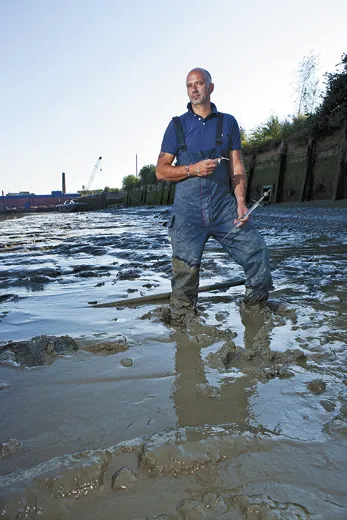
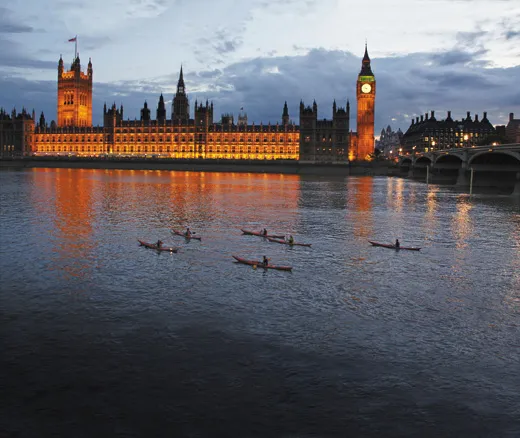
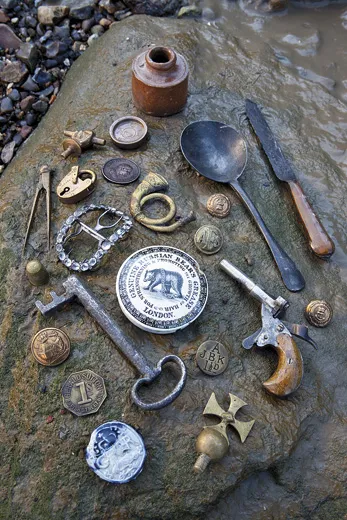
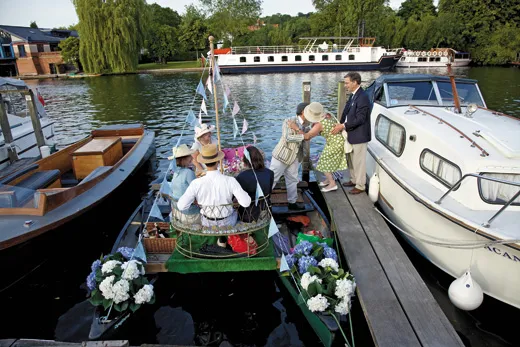
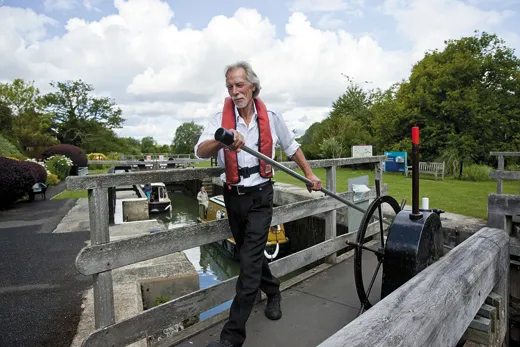
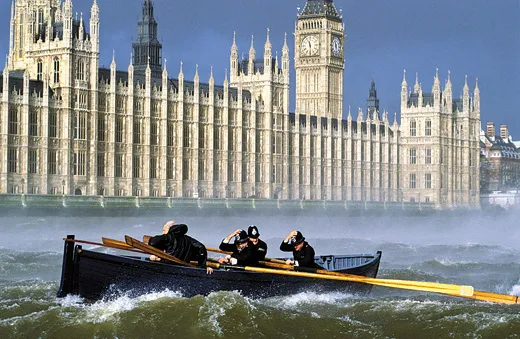


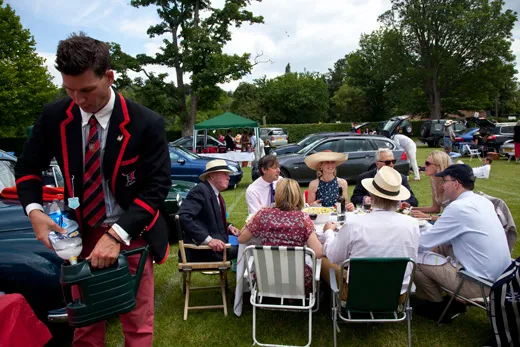
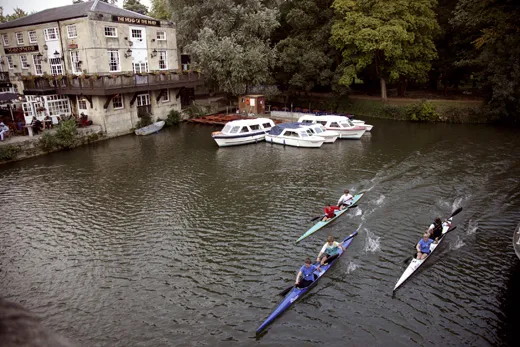

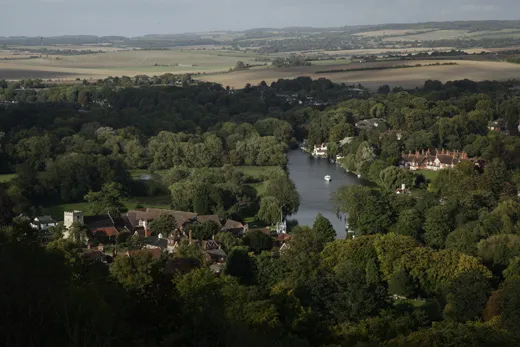
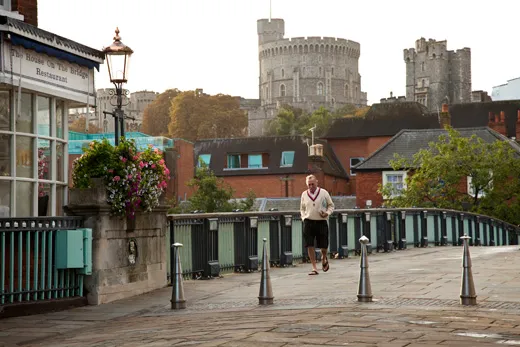
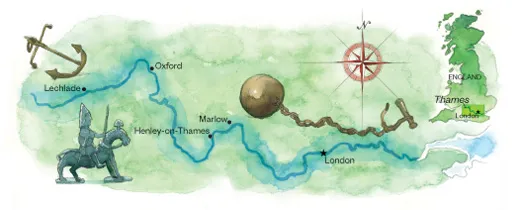
/https://tf-cmsv2-smithsonianmag-media.s3.amazonaws.com/accounts/headshot/Screen_Shot_2021-09-15_at_12.44.05_PM.png)